Abstract
The human end-stage kidney and its experimental analogue, the remnant kidney in the rat, exhibit widespread tubulo-interstitial disease. We investigated whether the pathogenesis of such tubulo-interstitial injury is dependent upon adaptive changes in tubular function and, in particular, in ammonia production when renal mass is reduced. Dietary acid load was reduced in 1 3/4-nephrectomized rats by dietary supplementation with sodium bicarbonate (NaHCO3), while control rats, paired for serum creatinine after 1 3/4 nephrectomy, were supplemented with equimolar sodium chloride. After 4-6 wk, NaHCO3-supplemented rats demonstrated less impairment of tubular function as measured by urinary excretory rates for total protein and low molecular weight protein and higher transport maximum for para-aminohippurate per unit glomerular filtration rate, less histologic evidence of tubulo-interstitial damage, less deposition of complement components C3 and C5b-9, and a lower renal vein total ammonia concentration. Such differences in tubular function could not be accounted for simply on the basis of systemic alkalinization, and differences in tubular injury could not be ascribed to differences in glomerular function. Because nitrogen nucleophiles such as ammonia react with C3 to form a convertase for the alternative complement pathway, and because increased tissue levels of ammonia are associated with increased tubulo-interstitial injury, we propose that augmented intrarenal levels of ammonia are injurious because of activation of the alternative complement pathway. Chemotactic and cytolytic complement components are thereby generated, leading to tubulo-interstitial inflammation. Thus, alkali supplementation reduces chronic tubulo-interstitial disease in the remnant kidney of the rat, and we propose that this results, at least in part, from reduction in cortical ammonia and its interaction with the alternative complement pathway.
Full text
PDF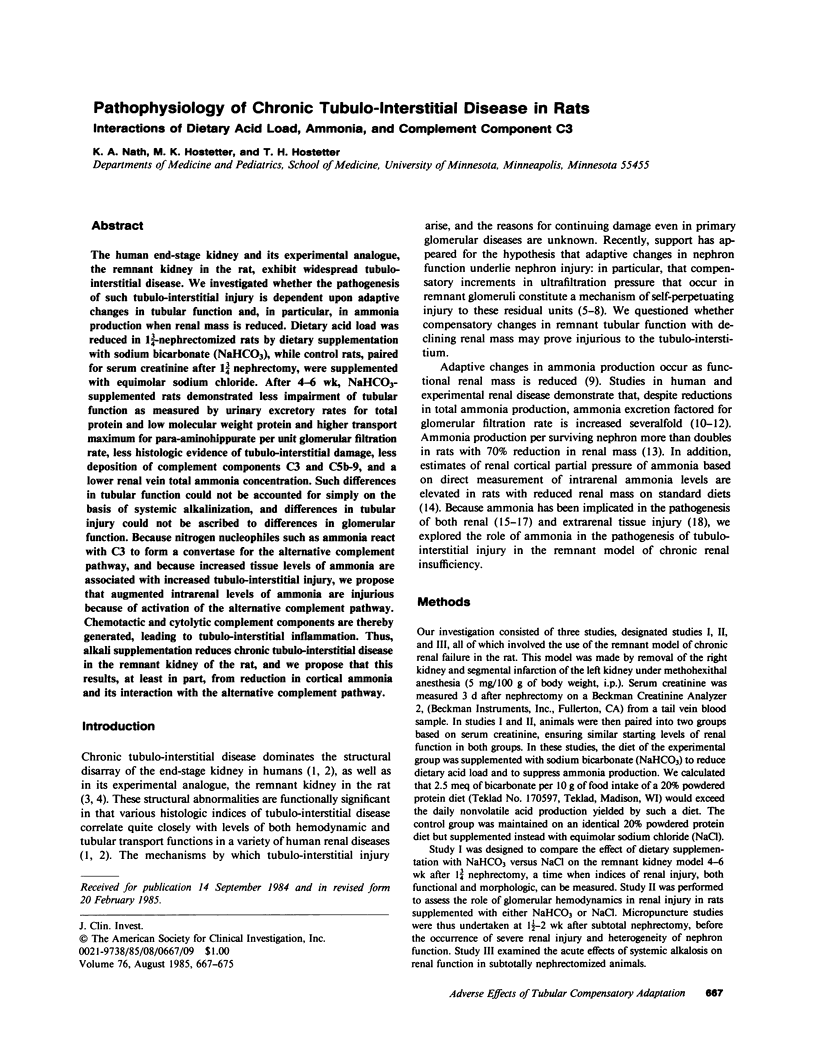
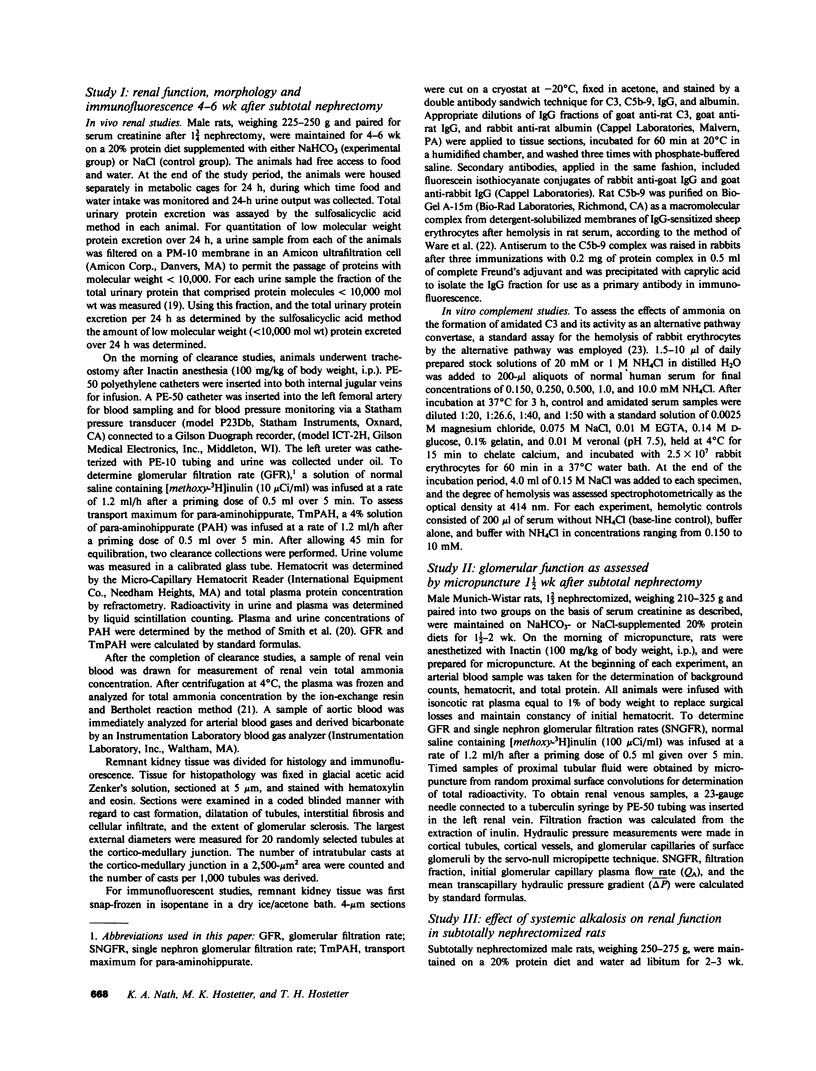
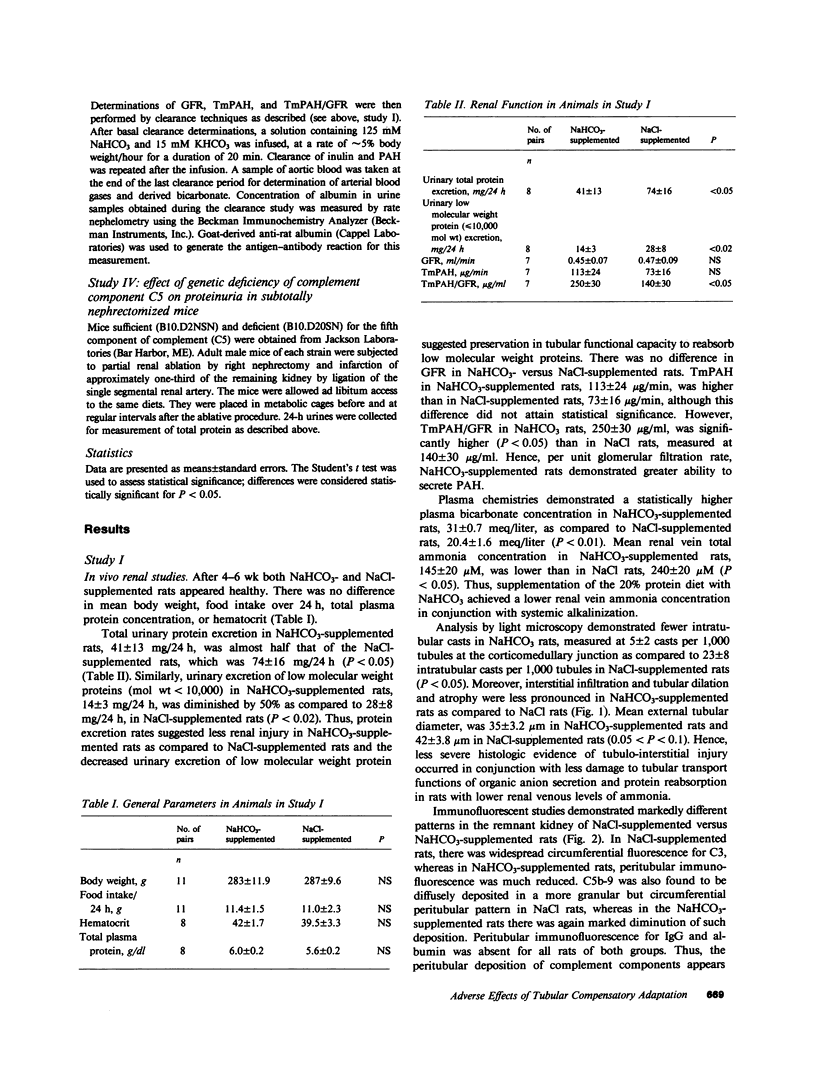

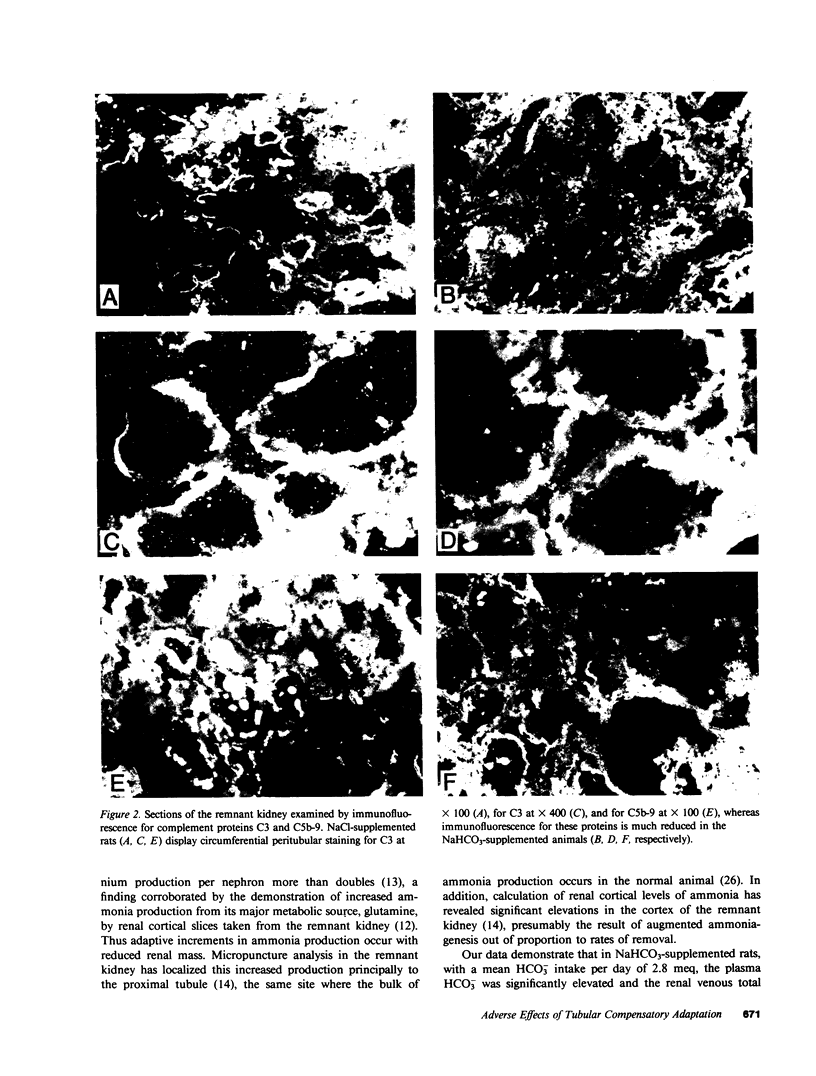
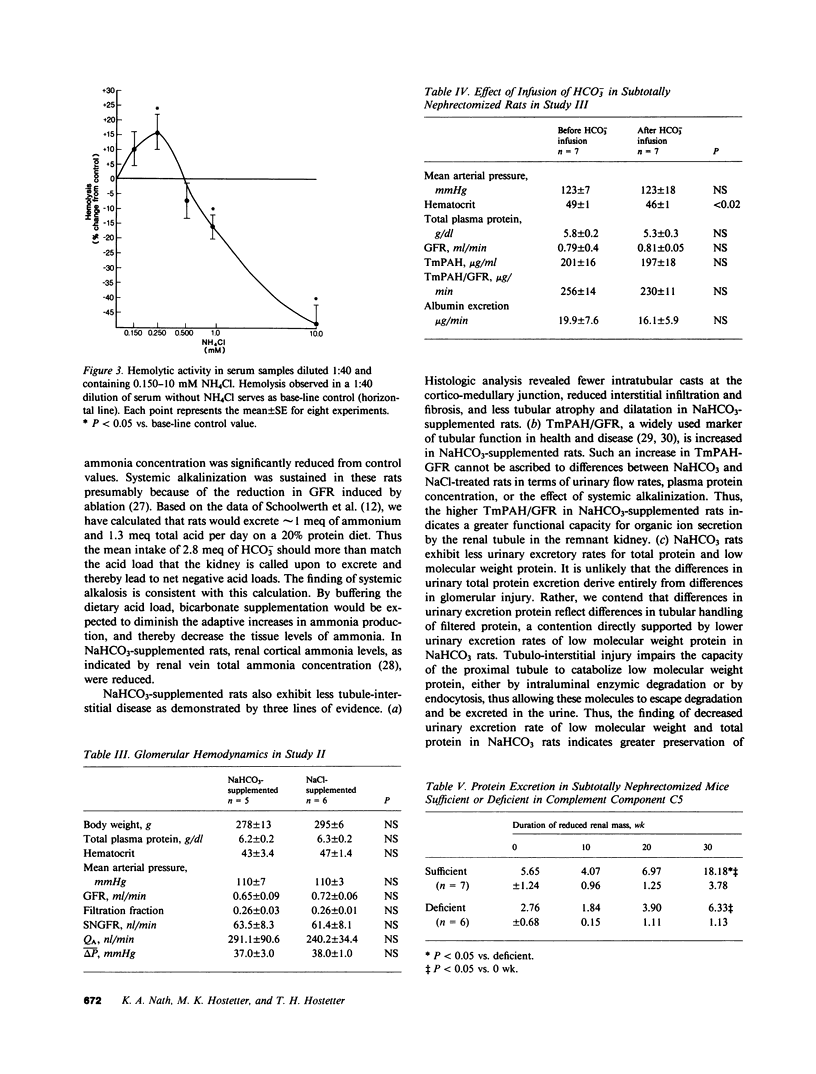


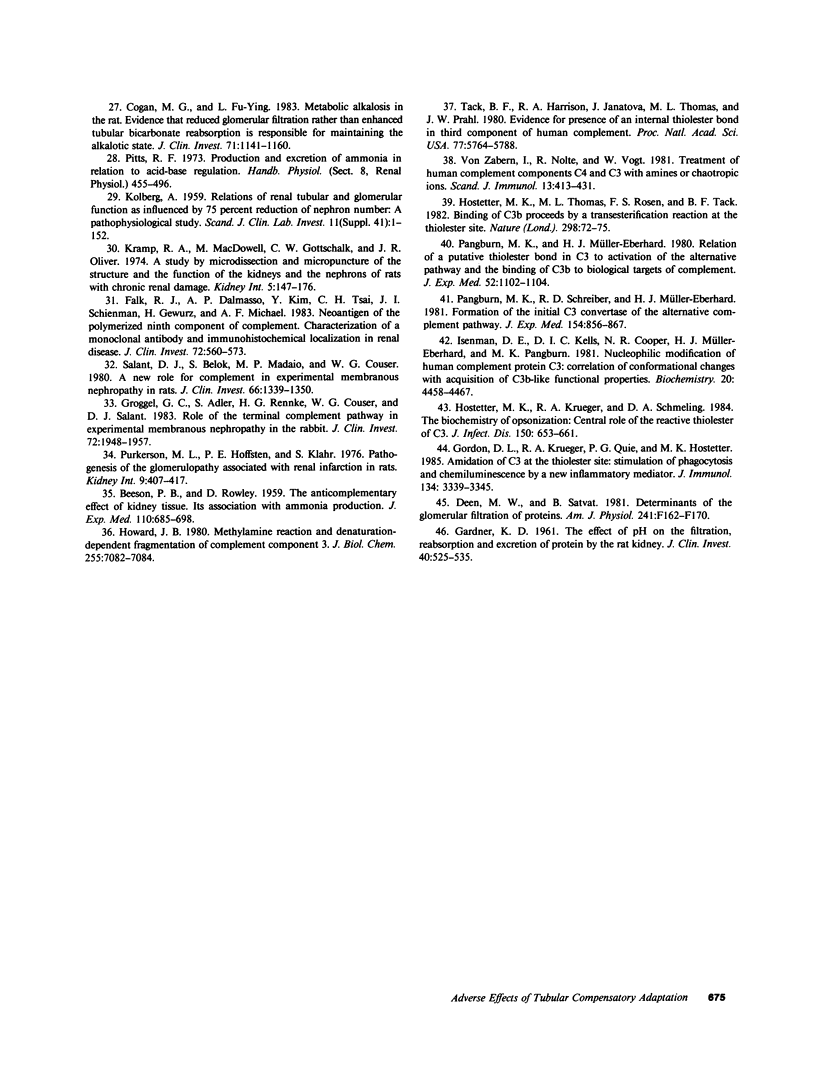
Images in this article
Selected References
These references are in PubMed. This may not be the complete list of references from this article.
- BEESON P. B., ROWLEY D. The anticomplementary effect of kidney tissue; its association with ammonia production. J Exp Med. 1959 Nov 1;110:685–697. doi: 10.1084/jem.110.5.685. [DOI] [PMC free article] [PubMed] [Google Scholar]
- Bohle A., Christ H., Grund K. E., Mackensen S. The role of the interstitium of the renal cortex in renal disease. Contrib Nephrol. 1979;16:109–114. doi: 10.1159/000402883. [DOI] [PubMed] [Google Scholar]
- Brenner B. M., Meyer T. W., Hostetter T. H. Dietary protein intake and the progressive nature of kidney disease: the role of hemodynamically mediated glomerular injury in the pathogenesis of progressive glomerular sclerosis in aging, renal ablation, and intrinsic renal disease. N Engl J Med. 1982 Sep 9;307(11):652–659. doi: 10.1056/NEJM198209093071104. [DOI] [PubMed] [Google Scholar]
- Buerkert J., Martin D., Trigg D., Simon E. Effect of reduced renal mass on ammonium handling and net acid formation by the superficial and juxtamedullary nephron of the rat. Evidence for impaired reentrapment rather than decreased production of ammonium in the acidosis of uremia. J Clin Invest. 1983 Jun;71(6):1661–1675. doi: 10.1172/JCI110921. [DOI] [PMC free article] [PubMed] [Google Scholar]
- Cogan M. G., Liu F. Y. Metabolic alkalosis in the rat. Evidence that reduced glomerular filtration rather than enhanced tubular bicarbonate reabsorption is responsible for maintaining the alkalotic state. J Clin Invest. 1983 May;71(5):1141–1160. doi: 10.1172/JCI110864. [DOI] [PMC free article] [PubMed] [Google Scholar]
- Deen W. M., Satvat B. Determinants of the glomerular filtration of proteins. Am J Physiol. 1981 Aug;241(2):F162–F170. doi: 10.1152/ajprenal.1981.241.2.F162. [DOI] [PubMed] [Google Scholar]
- Dorhout-Mees E. J., Machado M., Slatopolsky E., Klahr S., Bricker N. S. The functional adaptation of the diseased kidney. 3. Ammonium excretion. J Clin Invest. 1966 Mar;45(3):289–296. doi: 10.1172/JCI105342. [DOI] [PMC free article] [PubMed] [Google Scholar]
- Falk R. J., Dalmasso A. P., Kim Y., Tsai C. H., Scheinman J. I., Gewurz H., Michael A. F. Neoantigen of the polymerized ninth component of complement. Characterization of a monoclonal antibody and immunohistochemical localization in renal disease. J Clin Invest. 1983 Aug;72(2):560–573. doi: 10.1172/JCI111004. [DOI] [PMC free article] [PubMed] [Google Scholar]
- Fitzpatrick J. M., Monson J. R., Gunter P. A., Watkinson L. E., Wickham J. E. Renal accumulation of ammonia: the cause of post-ischaemic functional loss and the "blue line". Br J Urol. 1982 Dec;54(6):608–612. doi: 10.1111/j.1464-410x.1982.tb13606.x. [DOI] [PubMed] [Google Scholar]
- GARDNER K. D., Jr The effect of pH on the filtration, reabsorption, and excretion of protein by the rat kidney. J Clin Invest. 1961 Mar;40:525–535. doi: 10.1172/JCI104280. [DOI] [PMC free article] [PubMed] [Google Scholar]
- Good D. W., Burg M. B. Ammonia production by individual segments of the rat nephron. J Clin Invest. 1984 Mar;73(3):602–610. doi: 10.1172/JCI111250. [DOI] [PMC free article] [PubMed] [Google Scholar]
- Gordon D. L., Krueger R. A., Quie P. G., Hostetter M. K. Amidation of C3 at the thiolester site: stimulation of chemiluminescence and phagocytosis by a new inflammatory mediator. J Immunol. 1985 May;134(5):3339–3345. [PubMed] [Google Scholar]
- Groggel G. C., Adler S., Rennke H. G., Couser W. G., Salant D. J. Role of the terminal complement pathway in experimental membranous nephropathy in the rabbit. J Clin Invest. 1983 Dec;72(6):1948–1957. doi: 10.1172/JCI111159. [DOI] [PMC free article] [PubMed] [Google Scholar]
- Hayslett J. P. Functional adaptation to reduction in renal mass. Physiol Rev. 1979 Jan;59(1):137–164. doi: 10.1152/physrev.1979.59.1.137. [DOI] [PubMed] [Google Scholar]
- Hostetter M. K., Krueger R. A., Schmeling D. J. The biochemistry of opsonization: central role of the reactive thiolester of the third component of complement. J Infect Dis. 1984 Nov;150(5):653–661. doi: 10.1093/infdis/150.5.653. [DOI] [PubMed] [Google Scholar]
- Hostetter M. K., Thomas M. L., Rosen F. S., Tack B. F. Binding of C3b proceeds by a transesterification reaction at the thiolester site. Nature. 1982 Jul 1;298(5869):72–75. doi: 10.1038/298072b0. [DOI] [PubMed] [Google Scholar]
- Hostetter T. H., Olson J. L., Rennke H. G., Venkatachalam M. A., Brenner B. M. Hyperfiltration in remnant nephrons: a potentially adverse response to renal ablation. Am J Physiol. 1981 Jul;241(1):F85–F93. doi: 10.1152/ajprenal.1981.241.1.F85. [DOI] [PubMed] [Google Scholar]
- Howard J. B. Methylamine reaction and denaturation-dependent fragmentation of complement component 3. Comparison with alpha2-macroglobulin. J Biol Chem. 1980 Aug 10;255(15):7082–7084. [PubMed] [Google Scholar]
- Isenman D. E., Kells D. I., Cooper N. R., Müller-Eberhard H. J., Pangburn M. K. Nucleophilic modification of human complement protein C3: correlation of conformational changes with acquisition of C3b-like functional properties. Biochemistry. 1981 Jul 21;20(15):4458–4467. doi: 10.1021/bi00518a034. [DOI] [PubMed] [Google Scholar]
- KOLBERG A. Relations of renal tubular and glomerular function as influenced by 75 per cent reduction of nephron number. A patho-physiological study. Scand J Clin Lab Invest. 1959;11 (Suppl 41):1–152. [PubMed] [Google Scholar]
- Kramp R. A., MacDowell M., Gottschalk C. W., Oliver J. R. A study by microdissection and micropuncture of the structure and the function of the kidneys and the nephrons of rats with chronic renal damage. Kidney Int. 1974 Feb;5(2):147–176. doi: 10.1038/ki.1974.19. [DOI] [PubMed] [Google Scholar]
- LOWRY O. H., ROSEBROUGH N. J., FARR A. L., RANDALL R. J. Protein measurement with the Folin phenol reagent. J Biol Chem. 1951 Nov;193(1):265–275. [PubMed] [Google Scholar]
- MORRISON A. B. Experimentally induced chronic renal insufficiency in the rat. Lab Invest. 1962 Apr;11:321–332. [PubMed] [Google Scholar]
- MacClean A. J., Hayslett J. P. Adaptive change in ammonia excretion in renal insufficiency. Kidney Int. 1980 May;17(5):595–606. doi: 10.1038/ki.1980.70. [DOI] [PubMed] [Google Scholar]
- Mackensen-Haen S., Bader R., Grund K. E., Bohle A. Correlations between renal cortical interstitial fibrosis, atrophy of the proximal tubules and impairment of the glomerular filtration rate. Clin Nephrol. 1981 Apr;15(4):167–171. [PubMed] [Google Scholar]
- Mackensen S., Grund K. E., Sindjić M., Bohle A. Influence of the renal cortical interstitium on the serum creatinine concentration and serum creatinine clearance in different chronic sclerosing interstitial nephritides. Nephron. 1979;24(1):30–34. doi: 10.1159/000181679. [DOI] [PubMed] [Google Scholar]
- Nelson B., Ruddy S. Enhancing role of IgG in lysis of rabbit erythrocytes by the alternative pathway of human complement. J Immunol. 1979 May;122(5):1994–1999. [PubMed] [Google Scholar]
- Olson J. L., Hostetter T. H., Rennke H. G., Brenner B. M., Venkatachalam M. A. Altered glomerular permselectivity and progressive sclerosis following extreme ablation of renal mass. Kidney Int. 1982 Aug;22(2):112–126. doi: 10.1038/ki.1982.143. [DOI] [PubMed] [Google Scholar]
- Pangburn M. K., Müller-Eberhard H. J. Relation of putative thioester bond in C3 to activation of the alternative pathway and the binding of C3b to biological targets of complement. J Exp Med. 1980 Oct 1;152(4):1102–1114. doi: 10.1084/jem.152.4.1102. [DOI] [PMC free article] [PubMed] [Google Scholar]
- Pangburn M. K., Schreiber R. D., Müller-Eberhard H. J. Formation of the initial C3 convertase of the alternative complement pathway. Acquisition of C3b-like activities by spontaneous hydrolysis of the putative thioester in native C3. J Exp Med. 1981 Sep 1;154(3):856–867. doi: 10.1084/jem.154.3.856. [DOI] [PMC free article] [PubMed] [Google Scholar]
- Preuss H. G., Murdaugh H. V. The toxic effect of ammonia on renal cortical tubule function in vitro. J Lab Clin Med. 1968 Apr;71(4):561–572. [PubMed] [Google Scholar]
- Purkerson M. L., Hoffsten P. E., Klahr S. Pathogenesis of the glomerulopathy associated with renal infarction in rats. Kidney Int. 1976 May;9(5):407–417. doi: 10.1038/ki.1976.50. [DOI] [PubMed] [Google Scholar]
- Salant D. J., Belok S., Madaio M. P., Couser W. G. A new role for complement in experimental membranous nephropathy in rats. J Clin Invest. 1980 Dec;66(6):1339–1350. doi: 10.1172/JCI109987. [DOI] [PMC free article] [PubMed] [Google Scholar]
- Schainuck L. I., Striker G. E., Cutler R. E., Benditt E. P. Structural-functional correlations in renal disease. II. The correlations. Hum Pathol. 1970 Dec;1(4):631–641. doi: 10.1016/s0046-8177(70)80061-2. [DOI] [PubMed] [Google Scholar]
- Schoolwerth A. C., Sandler R. S., Hoffman P. M., Klahr S. Effects of nephron reduction and dietary protein content on renal ammoniagenesis in the rat. Kidney Int. 1975 Jun;7(6):397–404. doi: 10.1038/ki.1975.57. [DOI] [PubMed] [Google Scholar]
- Simpson D. P. Control of hydrogen ion homeostasis and renal acidosis. Medicine (Baltimore) 1971 Nov;50(6):503–541. doi: 10.1097/00005792-197111000-00002. [DOI] [PubMed] [Google Scholar]
- Smith H. W., Finkelstein N., Aliminosa L., Crawford B., Graber M. THE RENAL CLEARANCES OF SUBSTITUTED HIPPURIC ACID DERIVATIVES AND OTHER AROMATIC ACIDS IN DOG AND MAN. J Clin Invest. 1945 May;24(3):388–404. doi: 10.1172/JCI101618. [DOI] [PMC free article] [PubMed] [Google Scholar]
- Tack B. F., Harrison R. A., Janatova J., Thomas M. L., Prahl J. W. Evidence for presence of an internal thiolester bond in third component of human complement. Proc Natl Acad Sci U S A. 1980 Oct;77(10):5764–5768. doi: 10.1073/pnas.77.10.5764. [DOI] [PMC free article] [PubMed] [Google Scholar]
- WICKHAM J. E., SHARMA G. P. ENDOGENOUS AMMONIA FORMATION IN EXPERIMENTAL RENAL ISCHAEMIA. Lancet. 1965 Jan 23;1(7378):195–198. doi: 10.1016/s0140-6736(65)90978-5. [DOI] [PubMed] [Google Scholar]
- Ware C. F., Wetsel R. A., Kolb W. P. Physicochemical characterization of fluid phase (SC5b-9) and membrane derived (MC5b-9) attack complexes of human complement purified by immunoadsorbent affinity chromatography or selective detergent extraction. Mol Immunol. 1981 Jun;18(6):521–531. doi: 10.1016/0161-5890(81)90130-9. [DOI] [PubMed] [Google Scholar]
- von Zabern I., Nolte R., Vogt W. Treatment of human complement components C4 and C3 with amines or chaotropic ions. Evidence of a functional and structural change that provides uncleaved C4 and C3 with properties of their soluble activated froms, C4b and C3b. Scand J Immunol. 1981;13(5):413–431. doi: 10.1111/j.1365-3083.1981.tb00152.x. [DOI] [PubMed] [Google Scholar]










